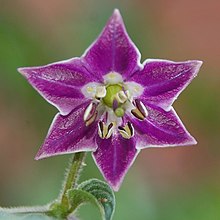Capsicum pubescens





| Capsicum pubescens | |
|---|---|
| Heat | Very Hot (SR: 50,000-250,000) |
The rocoto (Quechua), or locoto (Amayra) (Capsicum pubescens) is a medium sized round chili pepper common in Peru, Bolivia, Chile, Northern Argentina, and Ecuador. Rocoto pods have thick walls, like a bell pepper, but are quite hot. Foliage is dark green and pubescent (hairy). The plant has purple blossoms with yellow spots and the seeds are dark brown or black, whereas the seeds and seed-bearing membrane of most domesticated Capsicum species are light in color. Rocoto peppers are the only peppers with black seeds. The plants grow up to 6 ft (1.8 m) high if supported. Capsicum pubescens is a perennial, and if protected from frost and pruned back it will grow many years.
Rocoto is among the oldest of domesticated peppers, and was grown up to 5000 years ago. It is probably related to undomesticated peppers that still grow in South America (cardenasii, eximium, and others). Like C. baccatum and C. chinense, this pepper is a distinct species in the genus Capsicum; most other chili peppers are cultivars or hybrids of C. annuum.
The rocoto will grow well in temperate and even cool climates without hot summers, unlike most hot chilis.
Although most rocotos are red, there is also a yellow type that is common in the Caribbean and Mexico and an orange variety.
Other names for Rocoto: locoto, manzano, canario (the yellow type), caballo, & peron.
A popular dish in South America, the Peruvian rocoto relleno, is prepared by stuffing rocotos with a meat mixture. In Peru, rocotos are most often used in preparing ceviche. Furthermore rocotos are the most common hot peppers used to spice up most of their dishes.
In the United States, locoto sauce is sometimes available at Latin-American grocers. Locoto peppers themselves are available in some markets fresh, but also occasionally frozen.
External links
- An informative site generally dedicated to rocoto peppers
- A photograph-laden site (largely in german, with significant english translation) dedicated to Capsicum varietals, including rocoto.
- A small Peru-based guide to chili (sic.) peppers
- An Annotated Guide to Peruvian Restaurants
